tow CHEVROLET ASTRO 2002 Owners Manual
[x] Cancel search | Manufacturer: CHEVROLET, Model Year: 2002, Model line: ASTRO, Model: CHEVROLET ASTRO 2002Pages: 400, PDF Size: 2.67 MB
Page 9 of 400
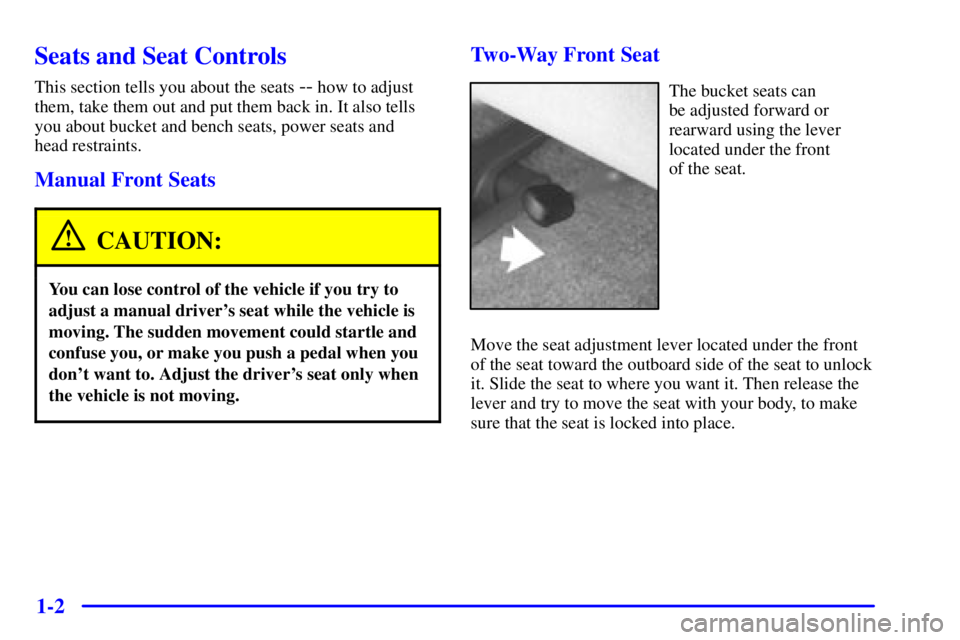
1-2
Seats and Seat Controls
This section tells you about the seats -- how to adjust
them, take them out and put them back in. It also tells
you about bucket and bench seats, power seats and
head restraints.
Manual Front Seats
CAUTION:
You can lose control of the vehicle if you try to
adjust a manual driver's seat while the vehicle is
moving. The sudden movement could startle and
confuse you, or make you push a pedal when you
don't want to. Adjust the driver's seat only when
the vehicle is not moving.
Two-Way Front Seat
The bucket seats can
be adjusted forward or
rearward using the lever
located under the front
of the seat.
Move the seat adjustment lever located under the front
of the seat toward the outboard side of the seat to unlock
it. Slide the seat to where you want it. Then release the
lever and try to move the seat with your body, to make
sure that the seat is locked into place.
Page 10 of 400
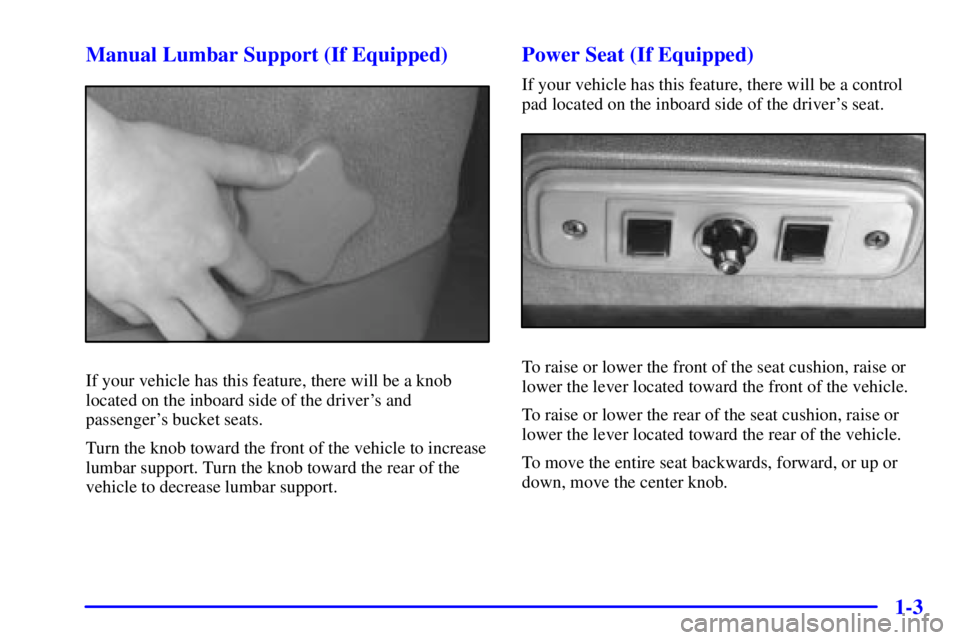
1-3 Manual Lumbar Support (If Equipped)
If your vehicle has this feature, there will be a knob
located on the inboard side of the driver's and
passenger's bucket seats.
Turn the knob toward the front of the vehicle to increase
lumbar support. Turn the knob toward the rear of the
vehicle to decrease lumbar support.
Power Seat (If Equipped)
If your vehicle has this feature, there will be a control
pad located on the inboard side of the driver's seat.
To raise or lower the front of the seat cushion, raise or
lower the lever located toward the front of the vehicle.
To raise or lower the rear of the seat cushion, raise or
lower the lever located toward the rear of the vehicle.
To move the entire seat backwards, forward, or up or
down, move the center knob.
Page 13 of 400
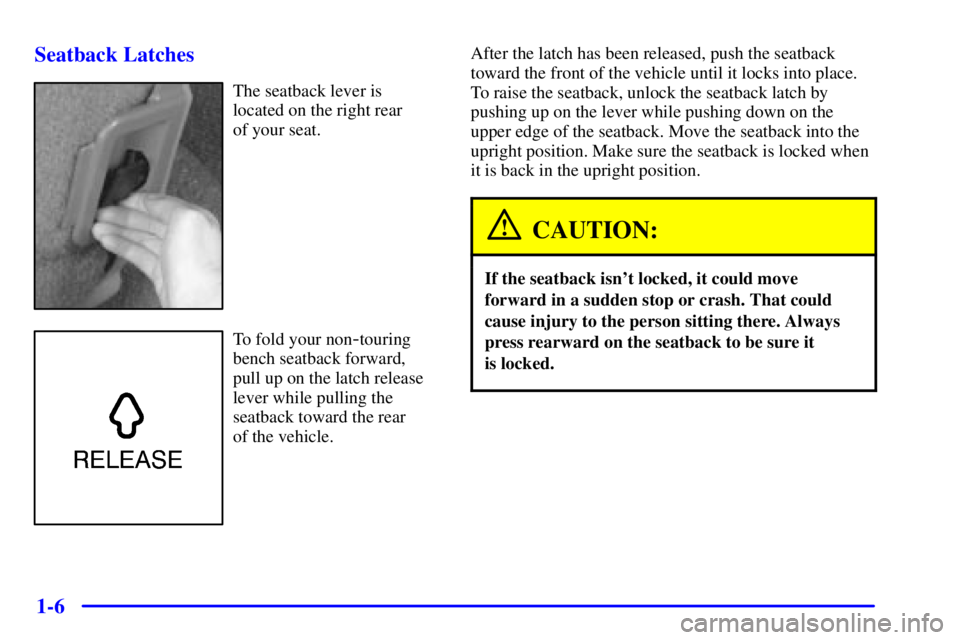
1-6 Seatback Latches
The seatback lever is
located on the right rear
of your seat.
To fold your non-touring
bench seatback forward,
pull up on the latch release
lever while pulling the
seatback toward the rear
of the vehicle.After the latch has been released, push the seatback
toward the front of the vehicle until it locks into place.
To raise the seatback, unlock the seatback latch by
pushing up on the lever while pushing down on the
upper edge of the seatback. Move the seatback into the
upright position. Make sure the seatback is locked when
it is back in the upright position.
CAUTION:
If the seatback isn't locked, it could move
forward in a sudden stop or crash. That could
cause injury to the person sitting there. Always
press rearward on the seatback to be sure it
is locked.
Page 14 of 400
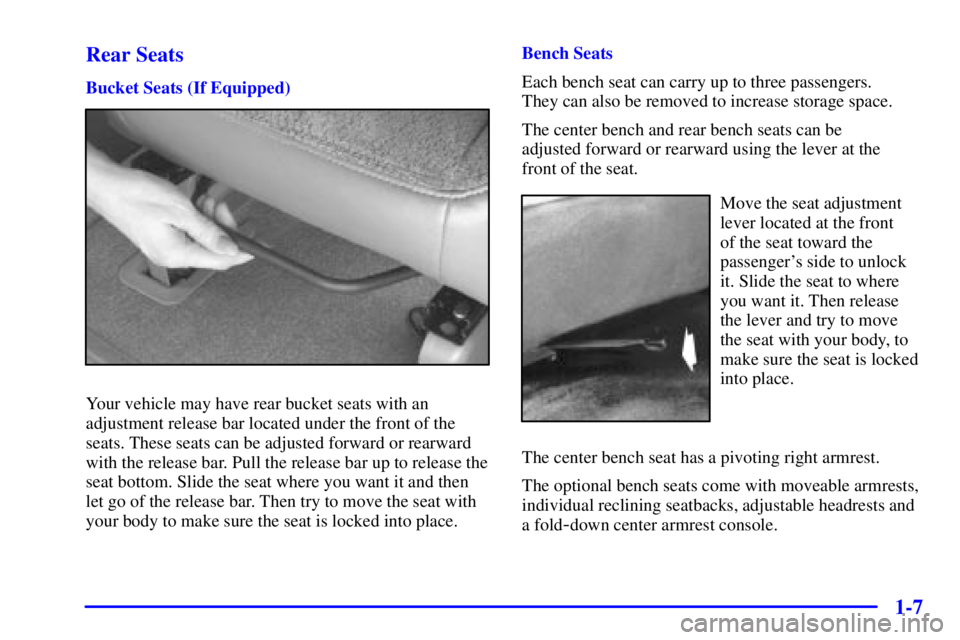
1-7 Rear Seats
Bucket Seats (If Equipped)
Your vehicle may have rear bucket seats with an
adjustment release bar located under the front of the
seats. These seats can be adjusted forward or rearward
with the release bar. Pull the release bar up to release the
seat bottom. Slide the seat where you want it and then
let go of the release bar. Then try to move the seat with
your body to make sure the seat is locked into place.Bench Seats
Each bench seat can carry up to three passengers.
They can also be removed to increase storage space.
The center bench and rear bench seats can be
adjusted forward or rearward using the lever at the
front of the seat.
Move the seat adjustment
lever located at the front
of the seat toward the
passenger's side to unlock
it. Slide the seat to where
you want it. Then release
the lever and try to move
the seat with your body, to
make sure the seat is locked
into place.
The center bench seat has a pivoting right armrest.
The optional bench seats come with moveable armrests,
individual reclining seatbacks, adjustable headrests and
a fold
-down center armrest console.
Page 19 of 400
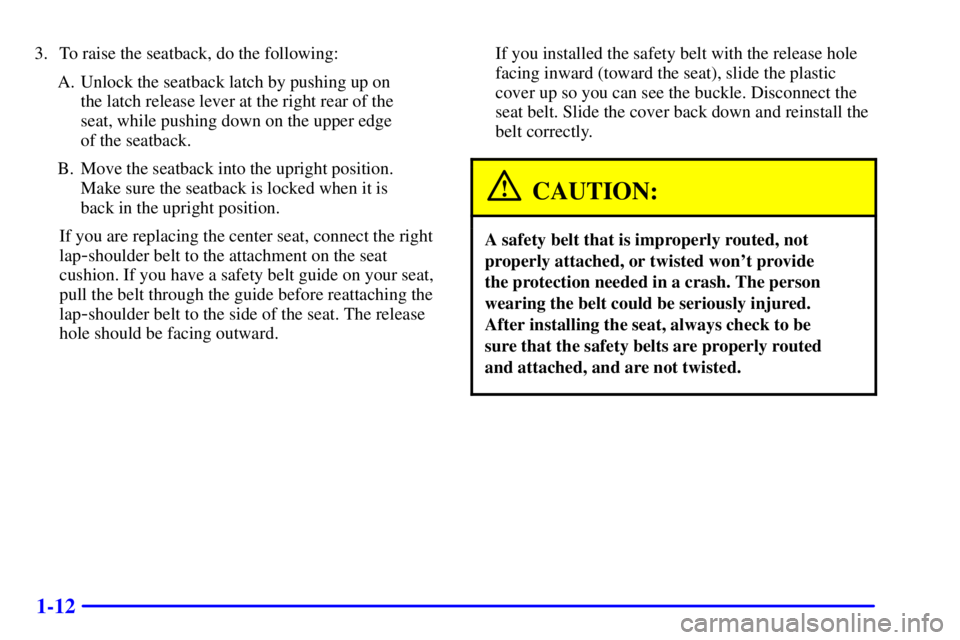
1-12
3. To raise the seatback, do the following:
A. Unlock the seatback latch by pushing up on
the latch release lever at the right rear of the
seat, while pushing down on the upper edge
of the seatback.
B. Move the seatback into the upright position.
Make sure the seatback is locked when it is
back in the upright position.
If you are replacing the center seat, connect the right
lap
-shoulder belt to the attachment on the seat
cushion. If you have a safety belt guide on your seat,
pull the belt through the guide before reattaching the
lap
-shoulder belt to the side of the seat. The release
hole should be facing outward.If you installed the safety belt with the release hole
facing inward (toward the seat), slide the plastic
cover up so you can see the buckle. Disconnect the
seat belt. Slide the cover back down and reinstall the
belt correctly.
CAUTION:
A safety belt that is improperly routed, not
properly attached, or twisted won't provide
the protection needed in a crash. The person
wearing the belt could be seriously injured.
After installing the seat, always check to be
sure that the safety belts are properly routed
and attached, and are not twisted.
Page 38 of 400

1-31
When should an air bag inflate?
An air bag is designed to inflate in a moderate to severe
frontal or near
-frontal crash. The air bag will inflate
only if the impact speed is above the system's designed
ªthreshold level.º If your vehicle goes straight into a
wall that doesn't move or deform, the threshold level is
about 9 to 16 mph (14 to 26 km/h). The threshold level
can vary, however, with specific vehicle design, so that
it can be somewhat above or below this range. If your
vehicle strikes something that will move or deform,
such as a parked car, the threshold level will be higher.
The air bag is not designed to inflate in rollovers, rear
impacts, or in many side impacts because inflation
would not help the occupant.
In any particular crash, no one can say whether an
air bag should have inflated simply because of the
damage to a vehicle or because of what the repair
costs were. Inflation is determined by the angle of
the impact and how quickly the vehicle slows down
in frontal or near
-frontal impacts.What makes an air bag inflate?
In an impact of sufficient severity, the air bag sensing
system detects that the vehicle is in a crash. The sensing
system triggers a release of gas from the inflator, which
inflates the air bag. The inflator, air bag and related
hardware are all part of the air bag modules inside the
steering wheel and in the instrument panel in front of
the right front passenger.
How does an air bag restrain?
In moderate to severe frontal or near
-frontal collisions,
even belted occupants can contact the steering wheel or
the instrument panel. Air bags supplement the protection
provided by safety belts. Air bags distribute the force
of the impact more evenly over the occupant's upper
body, stopping the occupant more gradually. But air
bags would not help you in many types of collisions,
including rollovers, rear impacts and many side impacts,
primarily because an occupant's motion is not toward
those air bags. Air bags should never be regarded as
anything more than a supplement to safety belts,
and then only in moderate to severe frontal or
near
-frontal collisions.
Page 55 of 400

1-48
Restraint Systems for Children
An infant car bed (A), a special bed made for use in a
motor vehicle, is an infant restraint system designed to
restrain or position a child on a continuous flat surface.
Make sure that the infant's head rests toward the center
of the vehicle.
A rear-facing infant seat (B) provides restraint with
the seating surface against the back of the infant.
The harness system holds the infant in place and, in a
crash, acts to keep the infant positioned in the restraint.
Page 70 of 400

1-63
CAUTION:
Never do this.
Here two children are wearing the same belt.
The belt can't properly spread the impact forces.
In a crash, the two children can be crushed
together and seriously injured. A belt must be
used by only one person at a time.
Q:What if a child is wearing a lap-shoulder belt,
but the child is so small that the shoulder belt is
very close to the child's face or neck?
A:Move the child toward the center of the vehicle, but
be sure that the shoulder belt still is on the child's
shoulder, so that in a crash the child's upper body
would have the restraint that belts provide. If the
child is sitting in a rear seat outside position, see
ªRear Safety Belt Comfort Guidesº in the Index.
If the child is so small that the shoulder belt is still
very close to the child's face or neck, you might
want to place the child in a seat that has a lap belt,
if your vehicle has one.
Page 79 of 400

2-6
Front Doors
To open a front door from the outside, grasp the handle
and pull the door open.
To open a front door from
the inside, pull the lever
toward you and push the
door open.
Rear Doors
If you have the ªDutch doors,º you must open the hatch
first. See ªHatch Releaseº in the Index.
Rear doors can only be
opened from the outside.
Open the passenger's
side rear door first. Grasp
the handle and pull the
door open.
Cargo Door Shown
Page 82 of 400
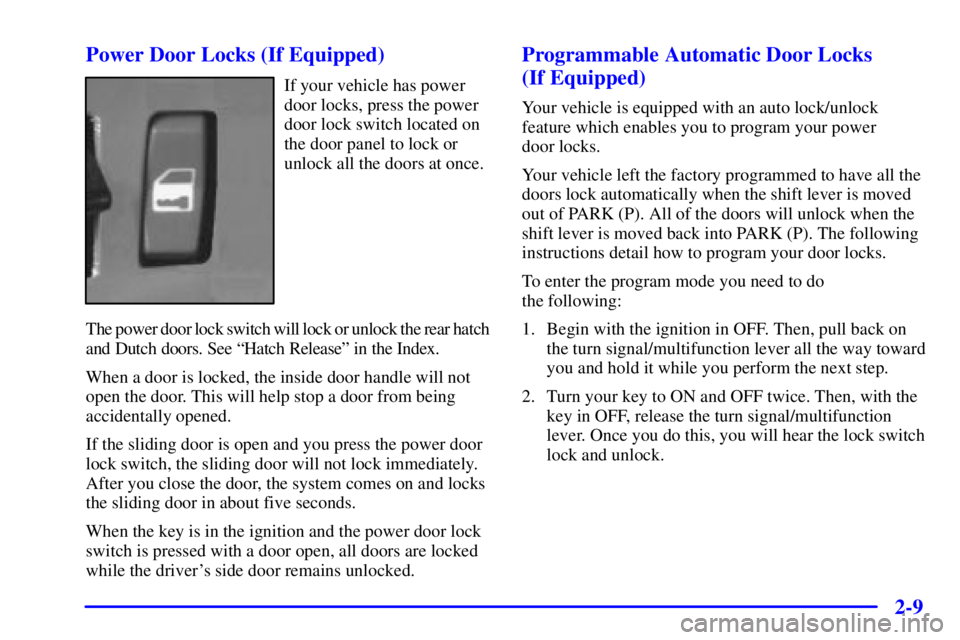
2-9 Power Door Locks (If Equipped)
If your vehicle has power
door locks, press the power
door lock switch located on
the door panel to lock or
unlock all the doors at once.
The power door lock switch will lock or unlock the rear hatch
and Dutch doors. See ªHatch Releaseº in the Index.
When a door is locked, the inside door handle will not
open the door. This will help stop a door from being
accidentally opened.
If the sliding door is open and you press the power door
lock switch, the sliding door will not lock immediately.
After you close the door, the system comes on and locks
the sliding door in about five seconds.
When the key is in the ignition and the power door lock
switch is pressed with a door open, all doors are locked
while the driver's side door remains unlocked.
Programmable Automatic Door Locks
(If Equipped)
Your vehicle is equipped with an auto lock/unlock
feature which enables you to program your power
door locks.
Your vehicle left the factory programmed to have all the
doors lock automatically when the shift lever is moved
out of PARK (P). All of the doors will unlock when the
shift lever is moved back into PARK (P). The following
instructions detail how to program your door locks.
To enter the program mode you need to do
the following:
1. Begin with the ignition in OFF. Then, pull back on
the turn signal/multifunction lever all the way toward
you and hold it while you perform the next step.
2. Turn your key to ON and OFF twice. Then, with the
key in OFF, release the turn signal/multifunction
lever. Once you do this, you will hear the lock switch
lock and unlock.